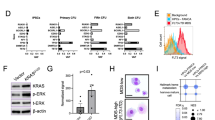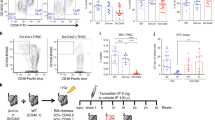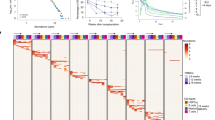Abstract
Malignant transformation of normal hematopoietic transplants induced by residual leukemia cells is considered as a pivotal mechanism of donor cell leukemia (DCL). The effects of leukemia cell–derived microvesicles (MVs) in this transformation were examined. We found that MVs derived from K562 leukemia cells contained the breakpoint cluster region–Abelson leukemia gene human homolog 1 (BCR-ABL1) mRNA. Following incubation with BCR-ABL1–positive MVs, mononuclear cells derived from normal transplants exhibited a leukemia-like malignant phenotype both in vitro and in vivo. Horizontal transfer of BCR-ABL1 mRNA from MVs into the recipient cells was critical to the transformation. Relative genomic instability was observed and considered the main mechanism in the recipient cells. MVs contributed to genomic instability by two distinct pathways: via consequent overexpression of activation-induced cytidine deaminase and reactive oxygen species, which mediated DNA breakage and recombination; and via upregulation of methyltransferases and global DNA hypermethylation. We demonstrated that BCR-ABL1–positive MVs could initiate malignant transformation of normal hematopoietic transplants through genomic instability, which might serve as a convenient and operable model for investigating leukemogenesis, especially for DCL. Furthermore, MVs themselves could act as an early warning indicator and a novel tool to detect and prevent the occurrence of DCL.
This is a preview of subscription content, access via your institution
Access options
Subscribe to this journal
Receive 12 print issues and online access
$259.00 per year
only $21.58 per issue
Buy this article
- Purchase on Springer Link
- Instant access to full article PDF
Prices may be subject to local taxes which are calculated during checkout






Similar content being viewed by others
References
Hamilton BK, Copelan EA . Concise review: the role of hematopoietic stem cell transplantation in the treatment of acute myeloid leukemia. Stem Cells 2012; 30: 1581–1586.
Brusic A, Wu CJ . Enhancing graft-versus-leukemia after transplant: the rise of anti-cancer vaccines. Front Biosci, (Landmark Ed.) 2012; 17: 635–655.
Wang E, Hutchinson CB, Huang Q, Lu CM, Crow J, Wang FF et al. Donor cell-derived leukemias/myelodysplastic neoplasms in allogeneic hematopoietic stem cell transplant recipients: a clinicopathologic study of 10 cases and a comprehensive review of the literature. Am J Clin Pathol 2011; 135: 525–540.
Ruiz-Arguelles A . Donor cell leukemia. Hematology 2012; 17 (Suppl 1): S69–S71.
Niederwieser DW, Appelbaum FR, Gastl G, Gersdorf E, Meister B, Geissler D et al. Inadvertent transmission of a donor’s acute myeloid leukemia in bone marrow transplantation for chronic myelocytic leukemia. N Engl J Med 1990; 322: 1794–1796.
Owen C, Barnett M, Fitzgibbon J . Familial myelodysplasia and acute myeloid leukaemia—a review. Br J Haematol 2008; 140: 123–132.
Yasunaga Ji Sakai T, Nosaka K, Ki Etoh, Tamiya S, Koga S et al. Impaired production of naive T lymphocytes in human T-cell leukemia virus type I-infected individuals: its implications in the immunodeficient state. Blood 2001; 97: 3177–3183.
Wakeford R . Radiation in the work place—a review of studies of the risks of occupational exposure to ionising radiation. J Radiol Prot 2009; 29: 61–79.
Martin I, Ruysschaert JM . Common properties of fusion peptides from diverse systems. Biosci Rep 2000; 20: 483–500.
Wiseman DH . Donor cell leukemia: a review. Biol Blood Marrow Transplant 2011; 17: 771–789.
Marmont A, Frassoni F, Bacigalupo A, Podestá M, Piaggio G, Van Lint MT et al. Recurrence of Ph'-positive leukemia in donor cells after marrow transplantation for chronic granulocytic leukemia. N Engl J Med 1984; 310: 903–906.
Duelli D, Lazebnik Y . Cell fusion: a hidden enemy? Cancer Cell 2003; 3: 445–448.
Raposo G, Stoorvogel W . Extracellular vesicles: exosomes, microvesicles, and friends. J Cell Biol 2013; 200: 373–383.
Jorfi S, Inal JM . The role of microvesicles in cancer progression and drug resistance. Biochem Soc Trans 2013; 41: 293–298.
Li J, Zhang Y, Liu Y, Dai X, Li W, Cai X et al. Microvesicle-mediated transfer of microRNA-150 from monocytes to endothelial cells promotes angiogenesis. J Biol Chem 2013; 288: 23586–23596.
Van der Pol E, Böing AN, Harrison P, Sturk A, Nieuwland R . Classification, functions, and clinical relevance of extracellular vesicles. Pharmacol Rev 2012; 64: 676–705.
Garcia-Olmo DC, Garcia-Olmo D . Biological role of cell-free nucleic acids in cancer: the theory of genometastasis. Crit Rev Oncog 2013; 18: 153–161.
Hertenstein B, Hambach L, Bacigalupo A, Schmitz N, McCann S, Slavin S et al. Development of leukemia in donor cells after allogeneic stem cell transplantation—a survey of the European Group for Blood and Marrow Transplantation (EBMT). Haematologica 2005; 90: 969–975.
Galick HA, Kathe S, Liu M, Robey-Bond S, Kidane D, Wallace SS et al. Germ-line variant of human NTH1 DNA glycosylase induces genomic instability and cellular transformation. Proc Natl Acad Sci USA 2013; 110: 14314–14319.
Lotze MT, Maranchie J, Appleman L . Inhibiting autophagy: a novel approach for the treatment of renal cell carcinoma. Cancer J 2013; 19: 341–347.
Ganem NJ, Godinho SA, Pellman D . A mechanism linking extra centrosomes to chromosomal instability. Nature 2009; 460: 278–282.
Kin C, Kidess E, Poultsides GA, Visser BC, Jeffrey SS . Colorectal cancer diagnostics: biomarkers, cell-free DNA, circulating tumor cells and defining heterogeneous populations by single-cell analysis. Expert Rev Mol Diagn 2013; 13: 581–599.
Lopez-Serra L, Ballestar E, Fraga MF, Alaminos M, Setien F, Esteller M et al. A profile of methyl-CpG binding domain protein occupancy of hypermethylated promoter CpG islands of tumor suppressor genes in human cancer. Cancer Res 2006; 66: 8342–8346.
Gao F, Shi L, Russin J, Zeng L, Chang X, He S et al. DNA methylation in the malignant transformation of meningiomas. PLoS One 2013; 8: e54114.
Honjo T, Kobayashi M, Begum N, Kotani A, Sabouri S, Nagaoka H et al. The AID dilemma: infection, or cancer? Adv Cancer Res 2012; 113: 1–44.
Jeon S, Han S, Lee K, Choi J, Park SK, Park AK et al. Genetic variants of AICDA/CASP14 associated with childhood brain tumor. Genet Mol Res 2013; 12: 2024–2031.
Bolton-Gillespie E, Schemionek M, Klein HU, Flis S, Hoser G, Lange T et al. Genomic instability may originate from imatinib-refractory chronic myeloid leukemia stem cells. Blood 2013; 121: 4175–4183.
Warsch W, Grundschober E, Berger A, Gille L, Cerny-Reiterer S, Tigan AS et al. STAT5 triggers BCR-ABL1 mutation by mediating ROS production in chronic myeloid leukaemia. Oncotarget 2012; 3: 1669–1687.
Poste G, Nicolson GL . Arrest and metastasis of blood-borne tumor cells are modified by fusion of plasma membrane vesicles from highly metastatic cells. Proc Natl Acad Sci USA 1980; 77: 399–403.
Principe S, Hui AB, Bruce J, Sinha A, Liu FF, Kislinger T . Tumor-derived exosomes and microvesicles in head and neck cancer: implications for tumor biology and biomarker discovery. Proteomics 2013; 13: 1608–1623.
Anthony DF, Shiels PG . Exploiting paracrine mechanisms of tissue regeneration to repair damaged organs. Transplant Res 2013; 2: 10.
Wu S, Ju GQ, Du T, Zhu YJ, Liu GH . Microvesicles derived from human umbilical cord Wharton's jelly mesenchymal stem cells attenuate bladder tumor cell growth in vitro and in vivo. PLoS One 2013; 8: e61366.
Cetin Z, Tezcan G, Karauzum SB, Kupesiz A, Manguoglu AE, Yesilipek A et al. Donor cell-derived acute myeloblastic leukemia after allogeneic peripheral blood hematopoietic stem cell transplantation for juvenile myelomonocytic leukemia. J Pediatr Hematol Oncol 2006; 28: 763–767.
Rodríguez-Macías G, Martínez-Laperche C, Gayoso J, Noriega V, Serrano D, Balsalobre P et al. Mutation of the NPM1 gene contributes to the development of donor cell-derived acute myeloid leukemia after unrelated cord blood transplantation for acute lymphoblastic leukemia. Hum Pathol 2013; 44: 1696–1699.
Kim JH, Chu SC, Gramlich JL, Pride YB, Babendreier E, Chauhan D et al. Activation of the PI3K/mTOR pathway by BCR-ABL contributes to increased production of reactive oxygen species. Blood 2005; 105: 1717–1723.
Camussi G, Deregibus MC, Bruno S, Grange C, Fonsato V, Tetta C . Exosome/microvesicle-mediated epigenetic reprogramming of cells. Am J Cancer Res 2011; 1: 98–110.
Jørgensen S, Schotta G, Sørensen CS . Histone H4 lysine 20 methylation: key player in epigenetic regulation of genomic integrity. Nucleic Acids Res 2013; 41: 2797–2806.
Deem AK, Li X, Tyler JK . Epigenetic regulation of genomic integrity. Chromosoma 2012; 121: 131–151.
Kanai Y, Hirohashi S . Alterations of DNA methylation associated with abnormalities of DNA methyltransferases in human cancers during transition from a precancerous to a malignant state. Carcinogenesis 2007; 28: 2434–2442.
Agarwal A, Polineni R, Hussein Z, Vigoda I, Bhagat TD, Bhattacharyya S et al. Role of epigenetic alterations in the pathogenesis of Barrett's esophagus and esophageal adenocarcinoma. Int J Clin Exp Pathol 2012; 5: 382–396.
Mishra A, Liu S, Sams GH, Curphey DP, Santhanam R, Rush LJ et al. Aberrant overexpression of IL-15 initiates large granular lymphocyte leukemia through chromosomal instability and DNA hypermethylation. Cancer Cell 2012; 22: 645–655.
Figueroa ME, Abdel-Wahab O, Lu C, Ward PS, Patel J, Shih A et al. Leukemic IDH1 and IDH2 mutations result in a hypermethylation phenotype, disrupt TET2 function, and impair hematopoietic differentiation. Cancer Cell 2010; 18: 553–567.
Lübbert M, Suciu S, Baila L, Rüter BH, Platzbecker U, Giagounidis A et al. Low-dose decitabine versus best supportive care in elderly patients with intermediate- or high-risk myelodysplastic syndrome (MDS) ineligible for intensive chemotherapy: final results of the randomized phase III study of the European Organisation for Research and Treatment of Cancer Leukemia Group and the German MDS Study Group. J Clin Oncol 2011; 29: 1987–1996.
Chang KH, Sanchez-Aguilera A, Shen S, Sengupta A, Madhu MN, Ficker AM et al. Vav3 collaborates with p190-BCR-ABL in lymphoid progenitor leukemogenesis, proliferation, and survival. Blood 2012; 120: 800–811.
Camussi G, Deregibus MC, Tetta C . Tumor-derived microvesicles and the cancer microenvironment. Curr Mol Med 2013; 13: 58–67.
Rautou PE, Mackman N . Del-etion of microvesicles from the circulation. Circulation 2012; 125: 1601–1604.
Dasgupta SK, Abdel-Monem H, Niravath P, Le A, Bellera RV, Langlois K et al. Lactadherin and clearance of platelet-derived microvesicles. Blood 2009; 113: 1332–1339.
Cocucci E, Racchetti G, Meldolesi J . Shedding microvesicles: artefacts no more. Trends Cell Biol 2009; 19: 43–51.
Acknowledgements
We thank Professor Zhijian Xiao (Institute of Haematology and Blood Diseases Hospital, Chinese Academy of Medical Sciences, Tianjin, China) for his kind supply of Imatinib. This work was supported by grants from the National Natural Science Foundation of China (Nos. 81170497 and 81170498).
Author information
Authors and Affiliations
Corresponding authors
Ethics declarations
Competing interests
The authors declare no conflict of interest.
Additional information
Supplementary Information accompanies this paper on the Leukemia website
Supplementary information
Rights and permissions
About this article
Cite this article
Zhu, X., You, Y., Li, Q. et al. BCR-ABL1–positive microvesicles transform normal hematopoietic transplants through genomic instability: implications for donor cell leukemia. Leukemia 28, 1666–1675 (2014). https://doi.org/10.1038/leu.2014.51
Received:
Revised:
Accepted:
Published:
Issue Date:
DOI: https://doi.org/10.1038/leu.2014.51
This article is cited by
-
The link between gestational diabetes and cardiovascular diseases: potential role of extracellular vesicles
Cardiovascular Diabetology (2022)
-
Transformation of Hematopoietic Stem and Progenitor Cells by Leukemia Extracellular Vesicles: A Step Toward Leukemogenesis
Stem Cell Reviews and Reports (2020)
-
LY86, LRG1 and PDE9A genes overexpression in umbilical cord blood hematopoietic stem progenitor cells by acute myeloid leukemia (M3) microvesicles
Experimental Hematology & Oncology (2019)
-
BCR-ABL1-positive microvesicles malignantly transform human bone marrow mesenchymal stem cells in vitro
Acta Pharmacologica Sinica (2017)
-
The emerging roles of tumor-derived exosomes in hematological malignancies
Leukemia (2017)



